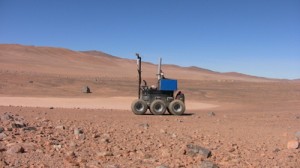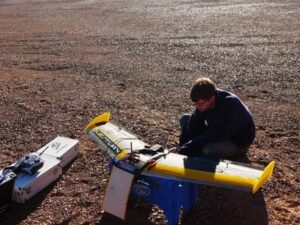The European Space Agency (ESA) challenged a top engineering team to devise a way for rovers to navigate on other planets. Six months later, a fully autonomous vehicle was charting its own course through Chile’s Mars-like Atacama Desert.
The recent test of the Seeker full-scale rover was the outcome of gathering a multidisciplinary team at a single site, working against the clock to achieve a breakthrough.
“Their challenge was to demonstrate how a planetary rover – programmed with state-of-the-art software for autonomous navigation and making decisions – could traverse 6 km in a Mars-like environment and come back where it started,” explained ESA’s Gianfranco Visentin.
Mars rovers cannot be ‘driven’ from Earth – it takes radio signals up to 40 minutes to make the trip to Mars and back. Instead, they are given instructions to carry out autonomously.
“ESA’s ExoMars rover, due to land on Mars in 2018, will have state-of-the-art autonomy,” added Gianfranco.
“However, it will not travel more than 150 m each martian day and not much more than 3 km throughout its mission.
“The difficulty comes with follow-on missions, which will require daily traverses of five to ten times longer.
“With longer journeys, the rover progressively loses sense of where it is.
“Lacking GPS on Mars, the rover can only determine how far it has moved relative to its starting point, but the errors in ‘dead reckoning’ build up into risky uncertainties.”
The team aimed at fixing their position on a map to 1 m accuracy. Seeker used its stereo vision to map its surroundings, assess how far it had moved and plan its route, making sure to avoid obstacles.
First, prototypes were tested indoors and outdoors. Then, in May, the Seeker team took their rover to the Atacama Desert, one of the driest places in the world – selected for its similarities to martian conditions.
“The European Southern Observatory’s nearby Very Large Telescope was an additional advantage,” Gianfranco added. “The observatory kindly provided refuge for the cold and windy desert nights.”
For two weeks the team put the rover into action within a particularly Mars-like zone. Like anxious parents, they watched the rover wander out of sight, maintaining only radio surveillance.
Their daily efforts culminated in the final trial, when Seeker was programmed to perform a 6 km loop.
“It took a whole day because the rover moves at a maximum 0.9 km/h,” Gianfranco recalled.
“But this was an unusual day. The usual desert winds counteracting the fierce heat of the Sun died away.
“The rover grew dangerously warm, and had to be stopped around midday. Then, when the wind finally picked up there wasn’t enough time to complete the loop before sundown.
“We managed 5.1 km, somewhat short of our 6 km goal, but an excellent result considering the variety of terrain crossed, changes in lighting conditions experienced and most of all this was ESA’s first large-scale rover test – though definitely not our last.”




















